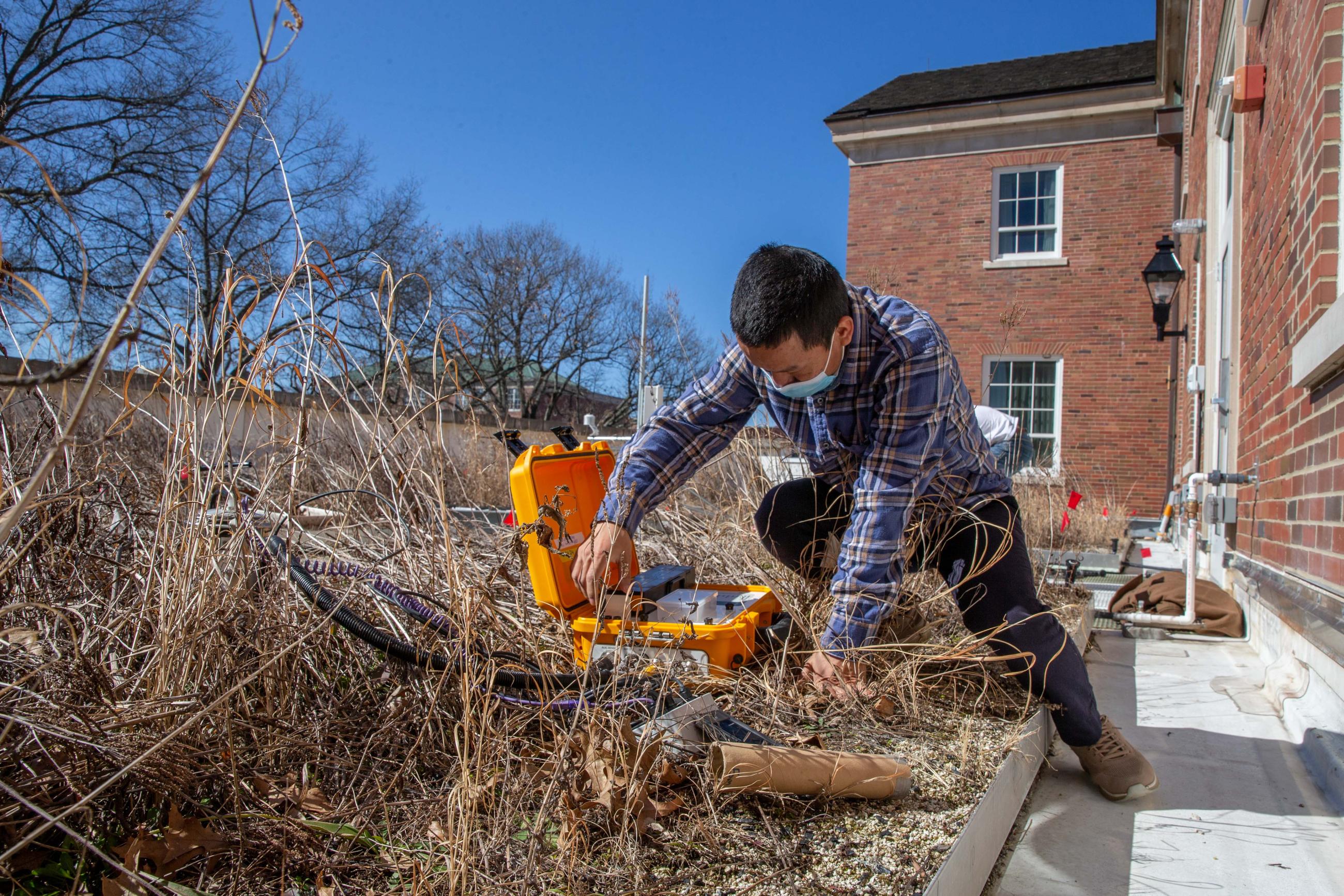
Carbon Flux

Bijay Gurung, an Environmental & Plant Biology MS student in Dr Rosenthal's lab, is studying the potential for a green roof to remove carbon from the atmosphere.
He writes:
Green roofs provide numerous benefits like stormwater retention, animal habitats, regulation of temperature in the building and on the roof surface, mitigation of the urban heat island effect, extended lifespan of the roof, and aesthetic value (Oberndorfer et al., 2007). A variety of plant types have been used in green roof systems including drought-tolerant succulents, grasses, and other herbaceous or woody plants.
Green roofs have also been studied recently for their potential to take up and store carbon. There are differences in carbon uptake between a green roof ecosystem and a natural ecosystem. In a natural ecosystem, such as grasslands, the majority of carbon that is sequestered is in the form of soil organic matter (SOM). SOM comprises decomposing plant residues, microbes, and humus (Luo & Zhou, 2006). While the green roof on the Schoonover Center consists of similar plants to those found in a grassland ecosystem, plants on the green roof are grown in an artificial substrate made up mostly of perlite, an engineered lightweight material, and has a different composition than soil. One of the major mineral soil components involved in the sequestration of SOM is clay. Clay helps soils to store carbon for long periods through the interaction of organic matters with the soil mineral particles which slows the decomposition process (Yang et al., 2021). In contrast to grasslands, extensive green roof substrates have little or no clay, which may lower sequestration of the carbon. Studies from Getter et al. (2009), Agra et al. (2017), and Kuronuma et al. (2018) provide information about carbon storage capacity of the green roof and plant types to enhance the potential of carbon storage. Green roofs with native grassland plants have been shown to assimilate more carbon than monocultures of succulent plants (Kuronuma et al., 2018) but few data exist describing the amount of carbon sequestered and lost via CO2 efflux (soil respiration) from grassland plants on green roof substrates.
Soil respiration is the process of the efflux of CO2 from the soil due to the respiratory activities of roots and soil microbes. Soil respiration comprises autotrophic and heterotrophic components, where autotrophic respiration relates to the respiration by the roots, mycorrhizae, and root-associated microbes and heterotrophic respiration involves the decomposition of the SOM by soil microbes that are free living (Hanson et al., 2000).
Soil respiration is an integral part of the global carbon cycle and can be affected by temperature, moisture and other factors. Generally, an increase in soil temperature, correlates to an increase in soil respiration. Increases in soil temperature increases soil respiration by promoting autotrophic (i.e., root) respiration and through an increase in heterotrophic (i.e., microbial) respiration. Soil moisture content is an equally important factor in soil respiration. Root respiration has been found to decrease in low soil moisture content. Soil moisture content can reduce the sensitivity of soil respiration to temperature. During drought conditions, the lower water availability has been found to limit the activity of plants and microbes (Shen et al., 2008). So, assessing the influence of the soil moisture and temperature in each component of the soil respiration will help in understanding the sensitivity of each component towards those factors.
Through this project, one of my objectives has been to study the autotrophic and heterotrophic component of the soil respiration of the newly established green roof on Schoonover Center and compare it to a restored prairie system adjacent to the Ohio Student Farm. This work will be the first to quantify and compare the autotrophic and heterotrophic component of soil respiration on the green roof and prairie. These data will reveal how each respiration component is influenced by soil temperature and soil moisture content and how these responses differ between natural soil and the green roof substrate.
References:
Agra, H., Klein, T., Vasl, A., Kadas, G., & Blaustein, L. (2017). Measuring the effect of plant-community composition on carbon fixation on green roofs. Urban Forestry & Urban Greening, 24, 1–4. https://doi.org/10.1016/j.ufug.2017.03.003
Getter, K. L., Rowe, D. B., Robertson, G. P., Cregg, B. M., & Andresen, J. A. (2009). Carbon sequestration potential of extensive green roofs. Environmental Science & Technology, 43(19), 7564–7570. https://doi.org/10.1021/es901539x
Hanson, P. J., Edwards, N. T., Garten, C. T., & Andrews, J. A. (2000). Separating root and soil microbial contributions to soil respiration: A review of methods and observations. Biogeochemistry, 48(1), 115–146. https://doi.org/10.1023/A:1006244819642
Kuronuma, T.; Watanabe, H. (2017). Physiological and morphological traits and competence for carbon sequestration of several green roof plants during the first year after construction. Am. J. Plant Sci., 8 (01), 14-27.
Kuronuma, T., Watanabe, H., Ishihara, T., Kou, D., Toushima, K., Ando, M., & Shindo, S. (2018). CO2 Payoff of Extensive Green Roofs with Different Vegetation Species. Sustainability, 10(7), 2256. https://doi.org/10.3390/su10072256
Luo, Y., & Zhou, X. (2006). Chapter 3—Processes of CO2 Production in Soil. In Y. Luo & X. Zhou (Eds.), Soil Respiration and the Environment (pp. 35–59). Academic Press. https://doi.org/10.1016/B978-012088782-8/50003-6
Oberndorfer, E., Lundholm, J., Bass, B., Coffman, R. R., Doshi, H., Dunnett, N., Gaffin, S., Köhler, M., Liu, K. K. Y., & Rowe, B. (2007). Green roofs as urban ecosystems: Ecological structures, functions, and services. BioScience, 57(10), 823–833. Scopus. https://doi.org/10.1641/B571005
Shen, W., Jenerette, G. D., Hui, D., Phillips, R. P., & Ren, H. (2008). Effects of changing precipitation regimes on dryland soil respiration and C pool dynamics at rainfall event, seasonal and interannual scales. Journal of Geophysical Research: Biogeosciences, 113(G3). https://doi.org/10.1029/2008JG000685
Yang, J. Q., Zhang, X., Bourg, I. C., & Stone, H. A. (2021). 4D imaging reveals mechanisms of clay-carbon protection and release. Nature Communications, 12(1), 622. https://doi.org/10.1038/s41467-020-20798-6
Photo Gallery
The following images are of Bijay Gurung and undergraduate student Robert Santiago conducting research on the Schoonover green roof.